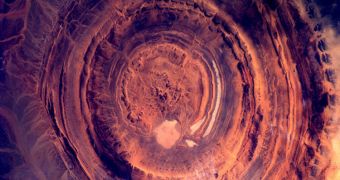Dutch astronaut Andre Kuipers, from the European Space Agency (ESA), was recently able to snap an impressive view of Richat structure, in Mauritania, as the International Space Station was flying above West Africa, over the Sahara Desert.
The formation, which is not a lava crater, looks mesmerizing in this new image, with its clearly defined rings defying geological explanations. Scientists still cannot say for sure how this structure developed, or how it came to look the way it does.
This copper-toned formation is located near the Atlantic coastlines, and features a large number of different rock layers. This is the main reason why the structure, which is also known as the Eye of the Sahara, looks so beautiful, Space reports.
It has a diameter of over 40 kilometers (24.8 miles), and erosion within the feature runs very deep. The rocks it contains were produced over time, from the Late Proterozoic to the Ordovician epochs (between 1 billion and 440 million years ago).
A wide variety of igneous rocks can be seen at the bottom of the structures, most of which are intrusions from deep underground, exposed by the heavy erosion. Richat represents a geologist's dream study site, since it features such a huge diversity of materials.
When first imaged from satellites, the feature was thought to be a large impact crater, most likely caused by an asteroid, because of its circular shape. However, subsequent analyses determined this to be false, and that more studies are needed before this collapsed dome is fully understood.
The new image is bound to help a lot in that regard, since it was collected from a unique vantage point, some 240 miles (386 kilometers) high in the exosphere. Kuipers used a Nikon D2Xs camera to collect this image on March 7.
The ESA astronaut launched to the ISS as part of Expedition 30 in December 2011. Alongside Russian cosmonaut Oleg Kononenko and NASA astronaut Don Pettit, he is scheduled to return home on July 1, aboard the Russian-built Soyuz TMA-03M space capsule.

 14 DAY TRIAL //
14 DAY TRIAL //